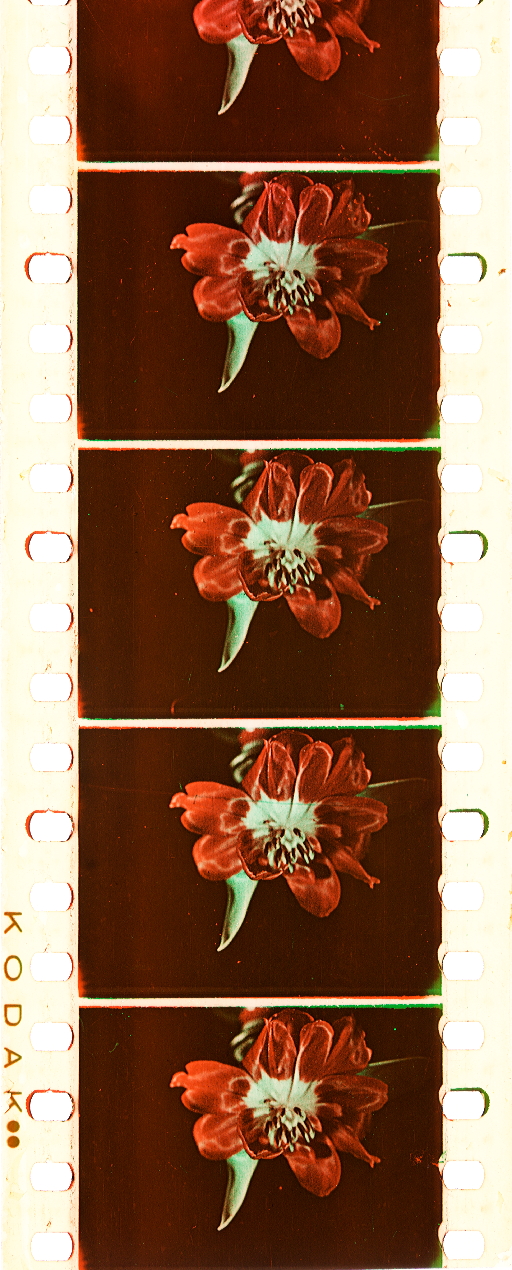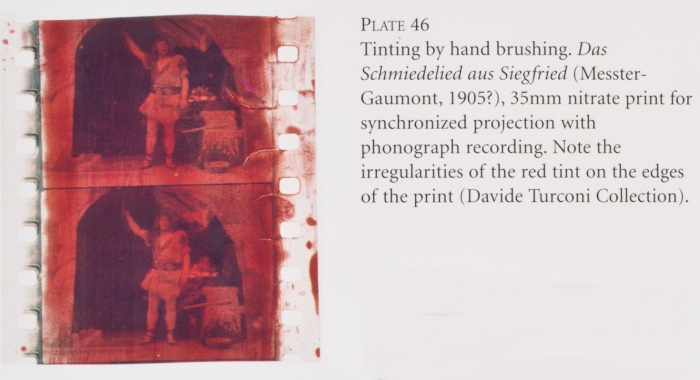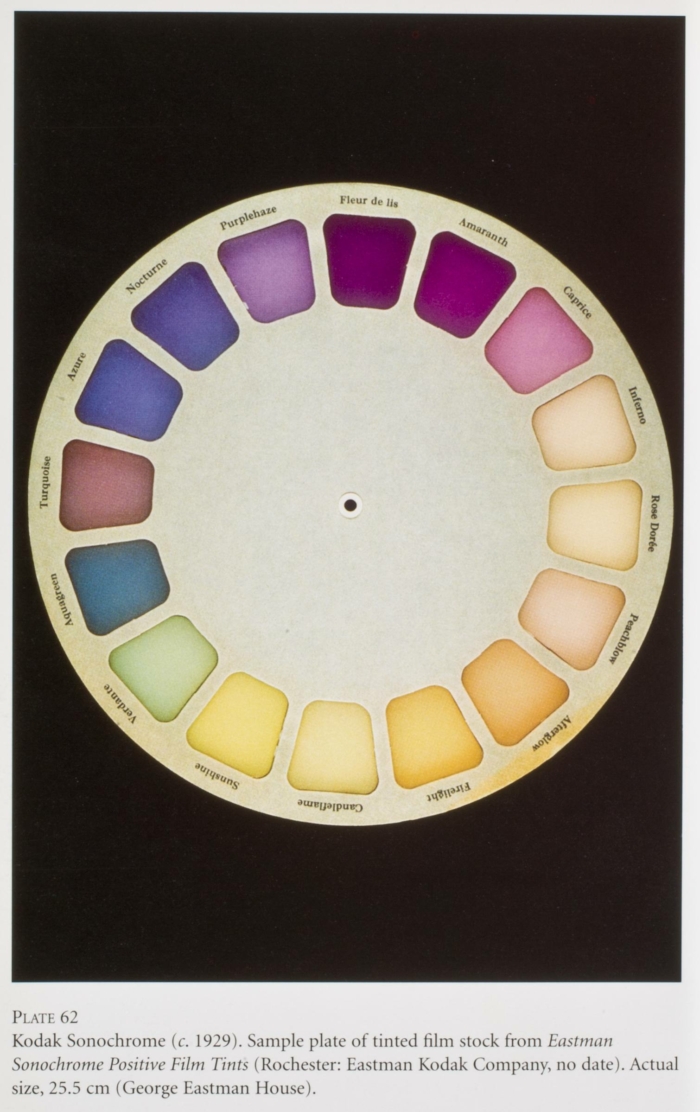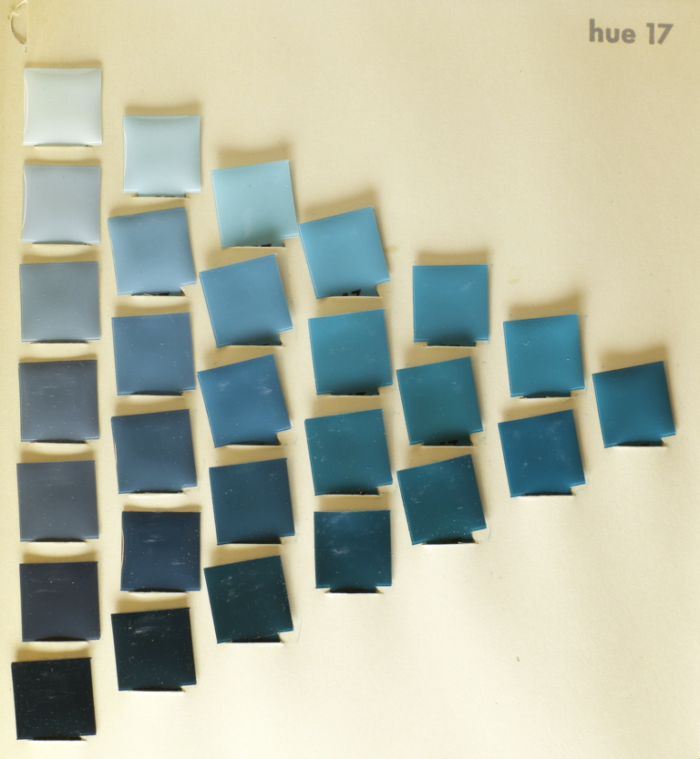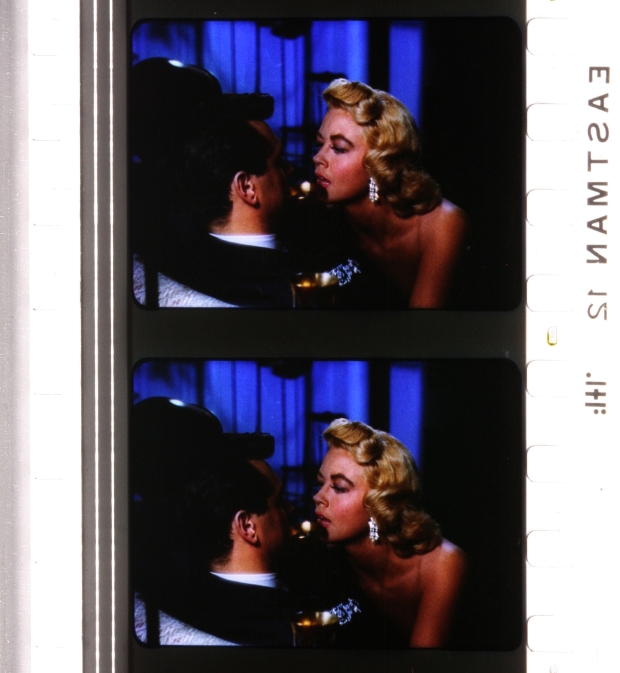-
![]() Credit: Cinémathèque française, conservatoire des techniques, Paris.
Credit: Cinémathèque française, conservatoire des techniques, Paris.
- Source: Coe, Brian (1981): The History of Movie Photography. Westfield, N.J.: Eastview Editions.
- Credit: Collection Gert Koshofer, Bergisch Gladbach (Germany).
- All Categories
- Bibliography
- Chromogenic monopack
- Chromolytic multilayer
- Color separation
- Double-coated / bi-pack
- Edge Codes and Identification
- Hand coloring
- Other
- Printing / dye-transfer
- Printing / pigment process
- Screen processes
- Spatial synthesis (multiple lenses, beam splitter)
- Stencil coloring (pochoir, Pathécolor)
- Temporal synthesis (rotary filters)
- Theory
- Tinting
- Toning
-
![]() Credit: Geo. Willeman, Nitrate Film Vault Manager, Library of Congress. Film: The Magic Isle.
Credit: Geo. Willeman, Nitrate Film Vault Manager, Library of Congress. Film: The Magic Isle.
- Credit: Geo. Willeman, Nitrate Film Vault Manager, Library of Congress. Film: The Magic Isle.
- Credit: Geo. Willeman, Nitrate Film Vault Manager, Library of Congress. Film: The Magic Isle.
- Credit: Geo. Willeman, Nitrate Film Vault Manager, Library of Congress. Film: The Magic Isle.
- Credit: Geo. Willeman, Nitrate Film Vault Manager, Library of Congress. Film: The Magic Isle.
- Credit: Geo. Willeman, Nitrate Film Vault Manager, Library of Congress. Film: The Magic Isle.
- Credit: Geo. Willeman, Nitrate Film Vault Manager, Library of Congress. Film: The Magic Isle.
- Credit: Geo. Willeman, Nitrate Film Vault Manager, Library of Congress. Film: The Magic Isle.
- Credit: Geo. Willeman, Nitrate Film Vault Manager, Library of Congress. Film: The Magic Isle.
- Credit: Geo. Willeman, Nitrate Film Vault Manager, Library of Congress. Film: The Magic Isle.
- Credit: Geo. Willeman, Nitrate Film Vault Manager, Library of Congress. Film: The Magic Isle.
- Credit: Geo. Willeman, Nitrate Film Vault Manager, Library of Congress. Film: The Magic Isle.
- Credit: Geo. Willeman, Nitrate Film Vault Manager, Library of Congress. Film: The Magic Isle.
- Credit: Geo. Willeman, Nitrate Film Vault Manager, Library of Congress. Film: The Magic Isle.
- Credit: Geo. Willeman, Nitrate Film Vault Manager, Library of Congress. Film: The Magic Isle.
- Credit: Geo. Willeman, Nitrate Film Vault Manager, Library of Congress. Film: The Magic Isle.
- Credit: Geo. Willeman, Nitrate Film Vault Manager, Library of Congress. Film: The Magic Isle.
- Credit: Geo. Willeman, Nitrate Film Vault Manager, Library of Congress. Film: The Magic Isle.
- Credit: Geo. Willeman, Nitrate Film Vault Manager, Library of Congress. Film: The Magic Isle.
- Credit: Geo. Willeman, Nitrate Film Vault Manager, Library of Congress. Film: The Magic Isle.
- Credit: Geo. Willeman, Nitrate Film Vault Manager, Library of Congress. Film: The Magic Isle.
- Credit: Geo. Willeman, Nitrate Film Vault Manager, Library of Congress. Film: The Magic Isle.
- Credit: Geo. Willeman, Nitrate Film Vault Manager, Library of Congress. Film: The Magic Isle.
- Credit: Geo. Willeman, Nitrate Film Vault Manager, Library of Congress. Film: The Magic Isle.
- Credit: Geo. Willeman, Nitrate Film Vault Manager, Library of Congress. Film: The Magic Isle.
- Credit: Geo. Willeman, Nitrate Film Vault Manager, Library of Congress. Film: The Magic Isle.
- Credit: Geo. Willeman, Nitrate Film Vault Manager, Library of Congress. Film: The Magic Isle.
- Credit: Geo. Willeman, Nitrate Film Vault Manager, Library of Congress. Film: The Magic Isle.
- Credit: Geo. Willeman, Nitrate Film Vault Manager, Library of Congress. Film: The Magic Isle.
- Credit: Geo. Willeman, Nitrate Film Vault Manager, Library of Congress. Film: The Magic Isle.
- Credit: Geo. Willeman, Nitrate Film Vault Manager, Library of Congress. Film: The Magic Isle.
- Credit: Geo. Willeman, Nitrate Film Vault Manager, Library of Congress. Film: The Magic Isle.
- Credit: Geo. Willeman, Nitrate Film Vault Manager, Library of Congress. Film: The Magic Isle.
- Credit: Geo. Willeman, Nitrate Film Vault Manager, Library of Congress. Film: The Magic Isle.
- Credit: Geo. Willeman, Nitrate Film Vault Manager, Library of Congress. Film: The Magic Isle.
- Credit: Geo. Willeman, Nitrate Film Vault Manager, Library of Congress. Film: The Magic Isle.
- Credit: Geo. Willeman, Nitrate Film Vault Manager, Library of Congress. Film: The Magic Isle.
- Credit: Geo. Willeman, Nitrate Film Vault Manager, Library of Congress. Film: The Magic Isle.
- Credit: Geo. Willeman, Nitrate Film Vault Manager, Library of Congress. Film: The Magic Isle.
- Credit: Geo. Willeman, Nitrate Film Vault Manager, Library of Congress. Film: The Magic Isle.
40 Images
Photographs of unidentified color film technologies. Several different principles and times. Feel free to contact us if you can help identifying them!
-
![]() Unidentified Processes from the Kodak Film Samples Collection and the Cinematography Collection.
Credit: National Science and Media Museum Bradford.
Photographs by Barbara Flueckiger in collaboration with Noemi Daugaard, SNSF Film Colors.
Unidentified Processes from the Kodak Film Samples Collection and the Cinematography Collection.
Credit: National Science and Media Museum Bradford.
Photographs by Barbara Flueckiger in collaboration with Noemi Daugaard, SNSF Film Colors.
- Unidentified Processes from the Kodak Film Samples Collection and the Cinematography Collection. Credit: National Science and Media Museum Bradford. Photographs by Barbara Flueckiger in collaboration with Noemi Daugaard, SNSF Film Colors.
- Unidentified Processes from the Kodak Film Samples Collection and the Cinematography Collection. Credit: National Science and Media Museum Bradford. Photographs by Barbara Flueckiger in collaboration with Noemi Daugaard, SNSF Film Colors.
298 Images in 5 Galleries
-
![]() Magnification of an image area. Source: Eggert, John (1932): Kurzer Überblick über den Stand der Farbenkinematographie. Bericht über den VIII. Internationalen Kongress für wissenschaftliche und angewandte Photographie, Dresden 1931, pp. 214-222. Leipzig: J. A. Barth.
Magnification of an image area. Source: Eggert, John (1932): Kurzer Überblick über den Stand der Farbenkinematographie. Bericht über den VIII. Internationalen Kongress für wissenschaftliche und angewandte Photographie, Dresden 1931, pp. 214-222. Leipzig: J. A. Barth.
- Color chart. Credit: Guido Seeber Nachlass, Deutsche Kinemathek, Berlin. Source: Goergen, Jeanpaul (2010): Rotorange und blaugrün. Das Zweifarbenverfahren Ufacolor 1931-1940. In: Filmblatt, no. 43, pp. 77-92.
- Credit: Guido Seeber Nachlass, Deutsche Kinemathek, Berlin. Source: Goergen, Jeanpaul (2010): Rotorange und blaugrün. Das Zweifarbenverfahren Ufacolor 1931-1940. In: Filmblatt, no. 43, pp. 77-92.
- Source: Eggert, John (1932): Kurzer Überblick über den Stand der Farbenkinematographie. Bericht über den VIII. Internationalen Kongress für wissenschaftliche und angewandte Photographie, Dresden 1931, pp. 214-222. Leipzig: J. A. Barth.
- Credit: Bundesarchiv-Filmarchiv, photo: Marian Stefanowski. Source: Goergen, Jeanpaul (2010): Rotorange und blaugrün. Das Zweifarbenverfahren Ufacolor 1931-1940. In: Filmblatt, no. 43, pp. 77-92. Film: Bunte Tierwelt. Studien in Hagebecks Tierpark in Stellingen (1931).
- Credit: Bundesarchiv-Filmarchiv, photo: Marian Stefanowski. Source: Goergen, Jeanpaul (2010): Rotorange und blaugrün. Das Zweifarbenverfahren Ufacolor 1931-1940. In: Filmblatt, no. 43, pp. 77-92. Film: Karneval (1936).
- Credit: Bundesarchiv-Filmarchiv, photo: Jeanpaul Goergen. Source: Goergen, Jeanpaul (2010): Rotorange und blaugrün. Das Zweifarbenverfahren Ufacolor 1931-1940. In: Filmblatt, no. 43, pp. 77-92. Film: Bunte Fischwelt (1936).
- Credit: Bundesarchiv-Filmarchiv, photo: Marian Stefanowski. Source: Goergen, Jeanpaul (2010): Rotorange und blaugrün. Das Zweifarbenverfahren Ufacolor 1931-1940. In: Filmblatt, no. 43, pp. 77-92. Film: Karneval (1936).
- Credit: Deutsches Filminstitut DIF (Vicas Nachlass), photo: Jeanpaul Goergen. Source: Goergen, Jeanpaul (2010): Rotorange und blaugrün. Das Zweifarbenverfahren Ufacolor 1931-1940. In: Filmblatt, no. 43, pp. 77-92. Film: Potsdam (1934).
- Credit: Bundesarchiv-Filmarchiv, photo: Marian Stefanowski. Source: Goergen, Jeanpaul (2010): Rotorange und blaugrün. Das Zweifarbenverfahren Ufacolor 1931-1940. In: Filmblatt, no. 43, pp. 77-92. Film: Farben machen froh (1938).
- Magnification 5x. Credit: photomicrograph by Silvana Konermann.
- Magnification 10x. Credit: photomicrograph by Silvana Konermann.
- Magnification 20x. Credit: photomicrograph by Silvana Konermann.
- Source: Eggert, John (1932): Kurzer Überblick über den Stand der Farbenkinematographie. In:Bericht über den VIII. Internationalen Kongress für wissenschaftliche und angewandte Photographie, Dresden 1931, pp. 214-222. Leipzig: J. A. Barth.
- Magnification of an image area. Source: Eggert, John (1932): Kurzer Überblick über den Stand der Farbenkinematographie. In:Bericht über den VIII. Internationalen Kongress für wissenschaftliche und angewandte Photographie, Dresden 1931, pp. 214-222. Leipzig: J. A. Barth.
- Reflection on Ufacolor film. Source: Eggert, John (1932): Kurzer Überblick über den Stand der Farbenkinematographie. In:Bericht über den VIII. Internationalen Kongress für wissenschaftliche und angewandte Photographie, Dresden 1931, pp. 214-222. Leipzig: J. A. Barth.
- An opened splice of an Ufacolor positive shows the two colors used in the process. Credit: David Pfluger. Source: David Pfluger’s collection.
136 Images in 7 Galleries
-
![]() Source: Pénichon, Sylvie (2013): Twentieth Century Colour Photographs. The Complete Guide to Processes, Identification & Preservation. London, Los Angeles: Thames & Hudson, p. 103.
Source: Pénichon, Sylvie (2013): Twentieth Century Colour Photographs. The Complete Guide to Processes, Identification & Preservation. London, Los Angeles: Thames & Hudson, p. 103.
- Source: Pénichon, Sylvie (2013): Twentieth Century Colour Photographs. The Complete Guide to Processes, Identification & Preservation. London, Los Angeles: Thames & Hudson, p. 277.
- Source: Pénichon, Sylvie (2013): Twentieth Century Colour Photographs. The Complete Guide to Processes, Identification & Preservation. London, Los Angeles: Thames & Hudson, p. 138.
3 Images
In contrast to tinting, toning is not the simple immersion of a film into a dye bath but involves a chemical reaction converting the silver image. In this reaction the neutral silver image in the emulsion of the positive film is replaced by one consisting of colored metal compounds. These were usually iron ferrocyanide (Prussian Blue) for blue, copper ferrocyanide for red/brown, silver sulfide for sepia or rarely uranium ferrocyanide for reddish brown. Toning had been used in still photography before. But since film was projected on the screen it required translucent toning compounds.
-
![]() Hongarije (FRA 1926, Anonymous). Credit: EYE Film Museum. Photographs of the tinted, toned and stencil colored nitrate print by Olivia Kristina Stutz, ERC Advanced Grant FilmColors.
Hongarije (FRA 1926, Anonymous). Credit: EYE Film Museum. Photographs of the tinted, toned and stencil colored nitrate print by Olivia Kristina Stutz, ERC Advanced Grant FilmColors.
- Virages sur films à support teinté Pathé, Film teinté lavande (virage bleu) lavender tinted stock with blue toning, the same image from a different copy of the book, combination of tungsten backlight with daylight toplight. Photograph by Barbara Flueckiger. Source: Didiée, L. (1926): Le Film vierge Pathé. Manuel de développement et de tirage. Paris: Pathé. [quote id='16']
- Photomicrograph, 25x. Credit: Norbert Wey, Institute of Pathology, University of Zurich.
- Photomicrograph, 50x. Credit: Norbert Wey, Institute of Pathology, University of Zurich.
- Photomicrograph, 100x. Credit: Norbert Wey, Institute of Pathology, University of Zurich.
- Toning samples from the Tinting and Toning Workshop by Ulrich Ruedel, Seminar "Materiality of Film" by Barbara Flueckiger and Bregt Lameris, Department of Film Studies, University of Zurich, in collaboration with Lichtspiel / Kinemathek Bern, David Landolf and Brigitte Paulowitz.
- Toning samples from the Tinting and Toning Workshop by Ulrich Ruedel, Seminar "Materiality of Film" by Barbara Flueckiger and Bregt Lameris, Department of Film Studies, University of Zurich, in collaboration with Lichtspiel / Kinemathek Bern, David Landolf and Brigitte Paulowitz.
1549 Images in 62 Galleries
For tinting, the positive print is immersed into a variety of dye baths, scene by scene. To this end, the print has to be cut into the corresponding fragments and reassembled after the dyeing process. The dye homogeneously attaches over the entire image’s gelatin including the perforation area. Usually synthetic dyes were dissolved in a weak acid solution to form a chemical bond with the gelatin.
-
![]() Salomé (USA 1922, Charles Bryant). Credit: George Eastman Museum. Photographs of the tinted, toned and Handschiegl nitrate print by Barbara Flueckiger.
Salomé (USA 1922, Charles Bryant). Credit: George Eastman Museum. Photographs of the tinted, toned and Handschiegl nitrate print by Barbara Flueckiger.
- Photograph by Barbara Flueckiger. Source: Agfa Kine-Handbuch. Berlin: Actien-Gesellschaft für Anilin-Fabrikation. (around 1927, estimated).
- See Mazzanti (2009: 71). Credit: Cineteca di Bologna. Film: Lyda Borelli in Malombra (Italy, 1917).
- As coloured for South America, see Mazzanti (2009: 71). Credit: Cineteca di Bologna.
- As coloured for the domestic Italian market, see Mazzanti (2009: 71). Credit: Cineteca di Bologna.
- Photomicrograph, 25x. Credit: Norbert Wey, Institute of Pathology, University of Zurich.
- Photomicrograph, 50x. Credit: Norbert Wey, Institute of Pathology, University of Zurich.
- Photomicrograph, 50x. Credit: Norbert Wey, Institute of Pathology, University of Zurich.
- Credit: Lichtspiel / Kinemathek Bern. Film: Dagli Appennini alle Ande (ITA 1916, Umberto Paradisi). Photograph by Barbara Flueckiger.
- Credit: Lichtspiel / Kinemathek Bern. Film: Dagli Appennini alle Ande (ITA 1916, Umberto Paradisi). Photograph by Barbara Flueckiger.
- Credit: Lichtspiel / Kinemathek Bern. Film: Dagli Appennini alle Ande (ITA 1916, Umberto Paradisi). Photograph by Barbara Flueckiger.
- Credit: Lichtspiel / Kinemathek Bern. Film: Dagli Appennini alle Ande (ITA 1916, Umberto Paradisi). Photograph by Barbara Flueckiger.
- Credit: Lichtspiel / Kinemathek Bern. Film: Dagli Appennini alle Ande (ITA 1916, Umberto Paradisi). Photograph by Barbara Flueckiger.
- Credit: Lichtspiel / Kinemathek Bern. Film: Dagli Appennini alle Ande (ITA 1916, Umberto Paradisi). Photograph by Barbara Flueckiger.
- Credit: Lichtspiel / Kinemathek Bern. Film: Gaumont Woche.
- Credit: Lichtspiel / Kinemathek Bern. Film: Gaumont Woche.
- Credit: Lichtspiel / Kinemathek Bern. Film: Gaumont Woche.
- Credit: Lichtspiel / Kinemathek Bern. Film: Gaumont Woche.
- Credit: Lichtspiel / Kinemathek Bern. Film: Selznick News.
4492 Images in 111 Galleries
-
![]() Credit: Paolo Cherchi Usai. Source: Cherchi Usai, Paolo (2000): Silent Cinema. London: BFI.
Credit: Paolo Cherchi Usai. Source: Cherchi Usai, Paolo (2000): Silent Cinema. London: BFI.
- Source: The International Photographer, July 1929
- Source: The International Photographer, July 1929
- Source: The International Photographer, July 1929
- Source: The International Photographer, July 1929
79 Images in 3 Galleries
-
![]() Credit: Cinémathèque française, conservatoire des techniques, Paris. Film: Test for Jour de Fête.
Credit: Cinémathèque française, conservatoire des techniques, Paris. Film: Test for Jour de Fête.
- Principle of capturing and projecting lenticular film. Credit: Joakim Reuteler and Rudolf Gschwind, Digital Humanities Lab, University of Basel, Switzerland. Illustration by Sarah Steinbacher, Multimedia & E-Learning-Services, University of Zurich.
- Principle of capturing and projecting lenticular film. Credit: Joakim Reuteler and Rudolf Gschwind, Digital Humanities Lab, University of Basel, Switzerland. Illustration by Sarah Steinbacher, Multimedia & E-Learning-Services, University of Zurich.
3 Images
-
![]() Credit: Illustration by Sarah Steinbacher, Multimedia & E-Learning-Services, University of Zurich. Source: Ryan, Roderick T. (1977): A History of Motion Picture Color Technology. London: Focal Press.
Credit: Illustration by Sarah Steinbacher, Multimedia & E-Learning-Services, University of Zurich. Source: Ryan, Roderick T. (1977): A History of Motion Picture Color Technology. London: Focal Press.
- Source: Ryan, Roderick T. (1977): A History of Motion Picture Color Technology. London: Focal Press.
- Source: Kistler, L. R. (1945): The Projection of Thomascolor Motion Pictures. In: International Projectionist, 20,7, Jul., pp. 12–14.
- Source: Kistler, L. R. (1945): The Projection of Thomascolor Motion Pictures. In: International Projectionist, 20,7, Jul., pp. 12–14.
- Left: Thomascolor camera lens mount for converting standard motion picture camera into Thomascolor. Right: A closeup of the Thomascolor projector lens mount for standard film projectors. The inventor points out that this is all that is needed to convert a standard projector to Thomascolor. Source: Anonymous (1944): Thomascolor. Four-Color Process For Motion Pictures. In: International Projectionist, 19,10, Oct., pp. 7–9.
5 Images
-
![]() Source: Hübl, Arthur Freiherr von (1904): Die Dreifarbenphotographie mit besonderer Berücksichtigung des Dreifarbendruckes und der photographischen Pigmentbilder in natürlichen Farben. Halle a. S.: Druck und Verlang von Wilhelm Knapp. Photograph by Martin Weiss, ERC Advanced Grant FilmColors.
Source: Hübl, Arthur Freiherr von (1904): Die Dreifarbenphotographie mit besonderer Berücksichtigung des Dreifarbendruckes und der photographischen Pigmentbilder in natürlichen Farben. Halle a. S.: Druck und Verlang von Wilhelm Knapp. Photograph by Martin Weiss, ERC Advanced Grant FilmColors.
- Source: Hübl, Arthur Freiherr von (1904): Die Dreifarbenphotographie mit besonderer Berücksichtigung des Dreifarbendruckes und der photographischen Pigmentbilder in natürlichen Farben. Halle a. S.: Druck und Verlang von Wilhelm Knapp. Photograph by Martin Weiss, ERC Advanced Grant FilmColors.
- Source: Hübl, Arthur Freiherr von (1904): Die Dreifarbenphotographie mit besonderer Berücksichtigung des Dreifarbendruckes und der photographischen Pigmentbilder in natürlichen Farben. Halle a. S.: Druck und Verlang von Wilhelm Knapp. Photograph by Martin Weiss, ERC Advanced Grant FilmColors.
- Source: Hübl, Arthur Freiherr von (1904): Die Dreifarbenphotographie mit besonderer Berücksichtigung des Dreifarbendruckes und der photographischen Pigmentbilder in natürlichen Farben. Halle a. S.: Druck und Verlang von Wilhelm Knapp. Photograph by Martin Weiss, ERC Advanced Grant FilmColors.
- Source: Hübl, Arthur Freiherr von (1904): Die Dreifarbenphotographie mit besonderer Berücksichtigung des Dreifarbendruckes und der photographischen Pigmentbilder in natürlichen Farben. Halle a. S.: Druck und Verlang von Wilhelm Knapp. Photograph by Martin Weiss, ERC Advanced Grant FilmColors.
- Source: Hübl, Arthur Freiherr von (1904): Die Dreifarbenphotographie mit besonderer Berücksichtigung des Dreifarbendruckes und der photographischen Pigmentbilder in natürlichen Farben. Halle a. S.: Druck und Verlang von Wilhelm Knapp. Photograph by Martin Weiss, ERC Advanced Grant FilmColors.
- Source: Hübl, Arthur Freiherr von (1904): Die Dreifarbenphotographie mit besonderer Berücksichtigung des Dreifarbendruckes und der photographischen Pigmentbilder in natürlichen Farben. Halle a. S.: Druck und Verlang von Wilhelm Knapp. Photograph by Martin Weiss, ERC Advanced Grant FilmColors.
- Source: Hübl, Arthur Freiherr von (1904): Die Dreifarbenphotographie mit besonderer Berücksichtigung des Dreifarbendruckes und der photographischen Pigmentbilder in natürlichen Farben. Halle a. S.: Druck und Verlang von Wilhelm Knapp. Photograph by Martin Weiss, ERC Advanced Grant FilmColors.
- Source: Hübl, Arthur Freiherr von (1904): Three-Colour Photography. Three-Colour Printing and the Production of Photographic Pigment Pictures in Natural Colours. London: W.A. Penrose.
- Source: Hübl, Arthur Freiherr von (1904): Die Dreifarbenphotographie mit besonderer Berücksichtigung des Dreifarbendruckes und der photographischen Pigmentbilder in natürlichen Farben. Halle a. S.: Druck und Verlang von Wilhelm Knapp. Photograph by Martin Weiss, ERC Advanced Grant FilmColors.
11 Images
-
![]() Source: Jacobson, Egbert (1942): The Color Harmony Manual and How to Use It. Chicago: Color Laboratories Division, Container Corp. of America. Credit: Faber Birren Collection, Yale University. Photograph by Barbara Flueckiger.
Source: Jacobson, Egbert (1942): The Color Harmony Manual and How to Use It. Chicago: Color Laboratories Division, Container Corp. of America. Credit: Faber Birren Collection, Yale University. Photograph by Barbara Flueckiger.
1 Image
-
![]() Source: Ryan, Roderick T. (1977): A History of Motion Picture Color Technology. London: Focal Press.
Source: Ryan, Roderick T. (1977): A History of Motion Picture Color Technology. London: Focal Press.
1 Image
-
![]() Written on the Wind (1956). Credit: Harvard Film Archive, item no. 3663. Photograph by Barbara Flueckiger.
Written on the Wind (1956). Credit: Harvard Film Archive, item no. 3663. Photograph by Barbara Flueckiger.
- Credit: Harvard Film Archive, item no. 1781. Film: Le Ballon rouge (1956). Photograph by Barbara Flueckiger.
- Credit: Harvard Film Archive, item no. 1781. Film: Le Ballon rouge (1956). Photograph by Barbara Flueckiger.
- Surface emulsion side, raking light (tungsten). Credit: Carsta Knaack, HTW Berlin. Film: Robin Hood, 1973.
- Photomicrograph 16x, raking light. Credit: Carsta Knaack, HTW Berlin. Film: Robin Hood, 1973.
- Photomicrograph, toplight on white background. Credit: Carsta Knaack, HTW Berlin. Film: Robin Hood, 1973.
- Photomicrograph 6,4x, top light on white background: picture and perforation area with spots of dye, yellow edge. Credit: Carsta Knaack, HTW Berlin. Film: Ssssss (1973).
- Photomicrograph 10x, top light on white background: picture and perforation area with spots of dye, yellow edge, yellow dye in frame line. Credit: Carsta Knaack, HTW Berlin. Film: Ssssss (1973).
- Photomicrograph 16x, top light on white background: sound track and perforation area with spots of dye, yellow edge. Credit: Carsta Knaack, HTW Berlin. Film: Ssssss (1973).
- Raking light: surface of picture and perforation area with small spots of dye, yellow edge. Credit: Carsta Knaack, HTW Berlin. Film: Ssssss (1973).
- Surface emulsion side, raking light (tungsten). Credit: Carsta Knaack, HTW Berlin. Film: Robin Hood, 1973.
- Vertigo (USA 1958, Alfred Hitchcock). Credit: Harvard Film Archive, item no. 246. HDR photograph by Barbara Flueckiger.
2261 Images in 41 Galleries
-
![]() Credit: Image courtesy of the Academy Film Archive. Film: Gone with the Wind (USA 1939, Victor Fleming). Photograph by Barbara Flueckiger.
Credit: Image courtesy of the Academy Film Archive. Film: Gone with the Wind (USA 1939, Victor Fleming). Photograph by Barbara Flueckiger.
- Film: Samson and Delilah (US 1949, Cecil B. DeMille), trailer.
- Photomicrograph, 50x. Credit: Norbert Wey, Institute of Pathology, University of Zurich.
- Photomicrograph, 100x. Credit: Norbert Wey, Institute of Pathology, University of Zurich.
1881 Images in 65 Galleries
The third Technicolor process used the same camera as process no. II to combine a pair of frames of the red and green record respectively on the b/w negative (see image). In contrast to the former process, however, the two images were printed on one side of the positive by the dye transfer or imbibition process.
-
![]() King of Jazz (USA 1930, John Murray Anderson). Credit: Library of Congress. Photographs of the Technicolor No. III dye-tranfer nitrate print from 1930 and 1931 by Olivia Kristina Stutz, ERC Advanced Grant FilmColors.
King of Jazz (USA 1930, John Murray Anderson). Credit: Library of Congress. Photographs of the Technicolor No. III dye-tranfer nitrate print from 1930 and 1931 by Olivia Kristina Stutz, ERC Advanced Grant FilmColors.
- Credit: Images courtesy of the Margaret Herrick Library. Film: Corrine Griffith in The Garden of Eden. Photograph: Barbara Flueckiger.
- Credit: George Eastman House Motion Picture Department Collection. Film: Buffalo Bill’s Last Fight (USA 1927, John W. Noble).
- Technicolor ad in Photoplay, 1930. Source: Photoplay, 1930, see Media History Digital Library
- Technicolor ad in Photoplay, 1930. Source: Photoplay, 1930, see Media History Digital Library
- Photomicrograph, 10x. Credit: Silvana Konermann.
- Photomicrograph, 20x. Credit: Silvana Konermann.
- Doctor X (USA 1932, Michael Curtiz). Credit: UCLA Film & Television Archive. Photographs of the Technicolor No. III dye-tranfer nitrate print by Barbara Flueckiger.
- Doctor X (USA 1932, Michael Curtiz). Credit: UCLA Film & Television Archive. Photographs of the Technicolor No. III dye-tranfer nitrate print by Barbara Flueckiger.




